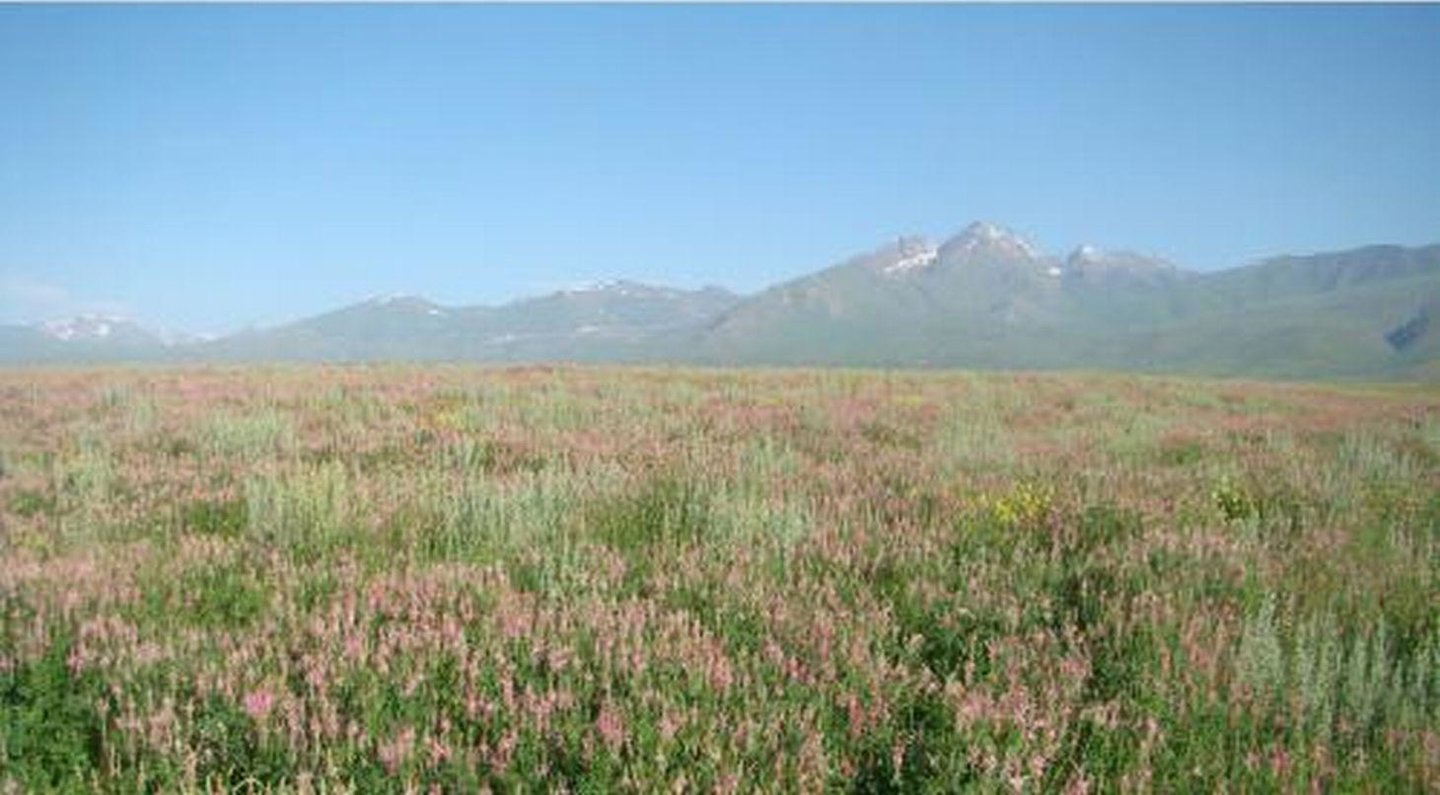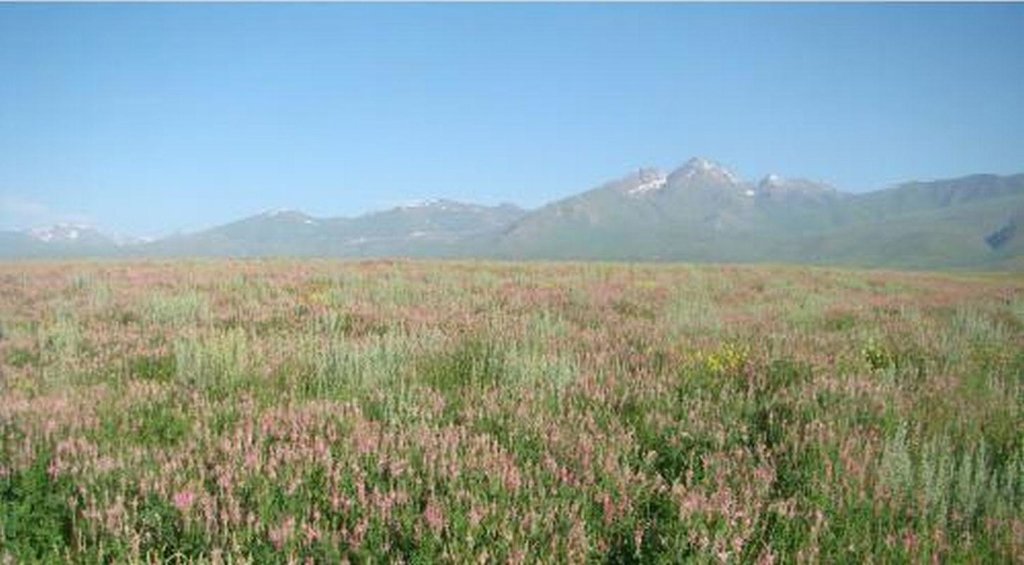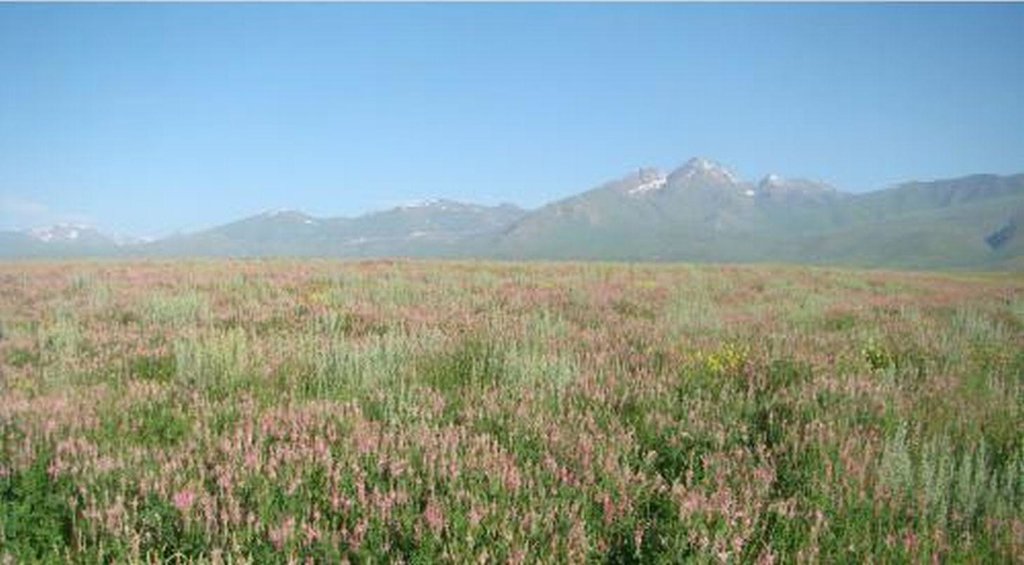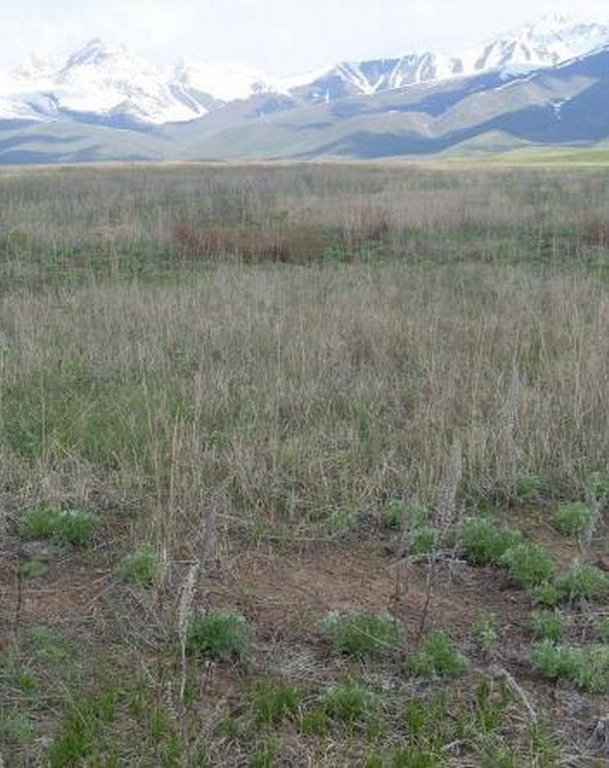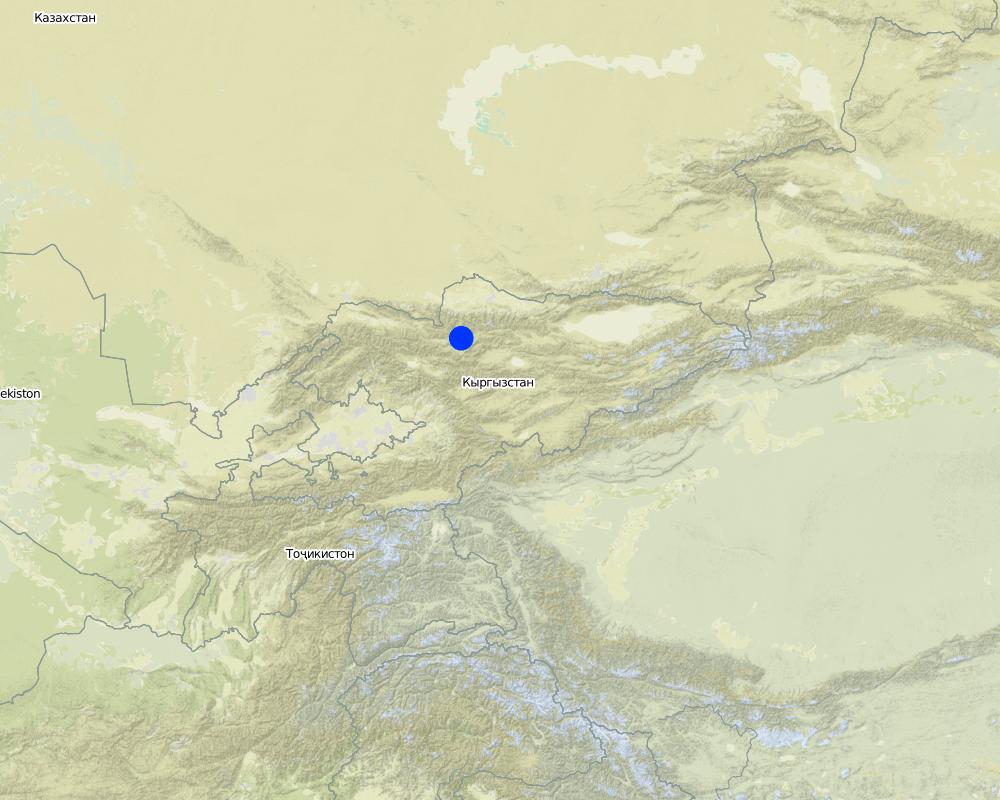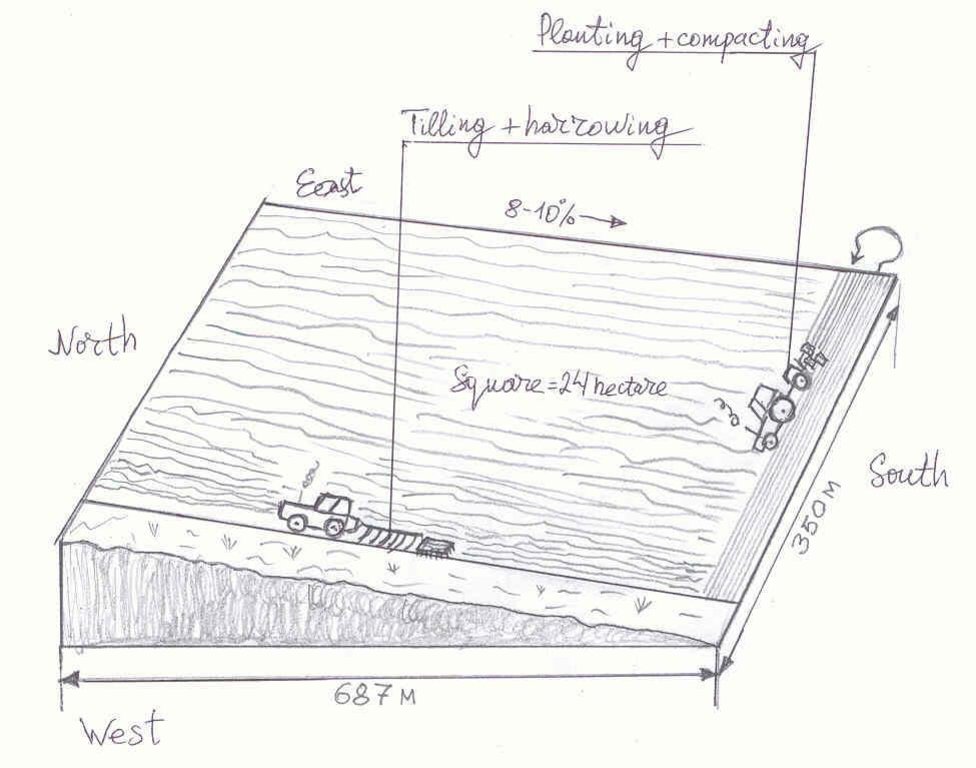Cultivation of sainfoin on high mountain pastures – Suusamyr Valley (in the frame of CACILM) [คีร์กีซสถาน]
- ผู้สร้างสรรค์:
- การอัพเดท:
- ผู้รวบรวม: Abdybek Asanaliev
- ผู้เรียบเรียง: –
- ผู้ตรวจสอบ: Alexandra Gavilano
Kyrgyzstan - Central Asian Countries Initiative for Land Management (CACILM/ИСЦАУЗР)
technologies_963 - คีร์กีซสถาน
- บทสรุปทั้งหมดในรูปแบบของ PDF
- บทสรุปทั้งหมดในรูปแบบของ PDF เพื่อพิมพ์
- บทสรุปทั้งหมดในรูปหน้าเว็บ
- บทสรุปทั้งหมด (ไม่มีการจัดเรียง)
- Cultivation of sainfoin on high mountain pastures – Suusamyr Valley (in the frame of CACILM): 27 ธันวาคม 2016 (inactive)
- Cultivation of sainfoin on high mountain pastures – Suusamyr Valley (in the frame of CACILM): 21 มีนาคม 2017 (inactive)
- Cultivation of sainfoin on high mountain pastures – Suusamyr Valley (in the frame of CACILM): 3 สิงหาคม 2017 (public)
ดูส่วนย่อย
ขยายทั้งหมด ย่อทั้งหมด1. ข้อมูลทั่วไป
1.2 รายละเอียดที่ติดต่อได้ของผู้รวบรวมและองค์กรที่เกี่ยวข้องในการประเมินและการจัดเตรียมทำเอกสารของเทคโนโลยี
วิทยากรหลัก
ผู้ใช้ที่ดิน:
Ibraimov 2 Section 2.5.3.2 cont Section 2.5.4.1 Section 2.5.4.2 Section 2.5.4.2 cont Section 2.6.1 Section 2.6.2 Section 2.7.1 - 2.7.3 Section 2.7.4 - 2.7.5 Section 2.7.6 - 2.7.7 Section 2.7.8 - 2.7.9 Section 2.7.10 - 2.7.14 Section 2.7.15 - 2.7.18 Section 2.8.1 - 2.8.4 Section 2.8.5 - 2.8.7 Section 2.8.8.1 - 2.8.8.3 Section 2.8.8.4 - 2.8.8.6 Section 2.8.9.1 - 2.8.9.2 Section 2.8.9.3 - 2.8.9.5 Section 2.8.10.1 - 2.8.10.2 Section 2.8.10.3 - 2.8.10.4 Section 2.8.11 Section 3.1.1.1 Section 3.1.1.2 Section 3.1.1.3 Section 3.1.1.4 Section 3.1.2 Section 3.1.3.1 Section 3.1.3.2 Section 3.1.3.3 Section 3.1.3.4 Section 3.1.4 Section 3.1.5 Section 3.2 Section 3.3 Section 3.4 ANNEX 1 ANNEX 2 ANNEX 3 Approve display Change log Questionnaire info Quality review/publication Reviewer records Add reviewer Manage reviewer records List all reviewer records Manage own records Downloads -QT Basic English - 432kb French - 463kb Spanish - 589kb Portuguese - 864kb Russian - 848kb Chinese - 805kb Turkish - 927kb -Picture format instructions Using IrfanView - 137kb IrfanView - 1.46MB WOCAT homepage Technology A new database is functional since August 4th 2016. Adding of new Technologies must be done using the new system. The migration of the WOCAT data to the new system will be done during the first half of 2017. It is possible to edit Technologies (which were added to the old database) in the new system once the migration of the data to the new system has been achieved. We will keep you informed about the migration process. Please email any enquiries or errors to wocat@cde.unibe.ch. Technology code: T_KYR004en PART 1: GENERAL INFORMATION 1.1 Contributing SLM specialist(s) Main contributor: Asanaliev, Abdybek Data collection date: 2011-01-14 List
Farmer in Susamyr valley
คีร์กีซสถาน
ผู้ใช้ที่ดิน:
Usubaliev Baibek
996 (312) 566 318
b.usubaliev@up.elcat.kg
ELCAT
Toktanaliev Street, # 4 A, room # 212,
คีร์กีซสถาน
ผู้ใช้ที่ดิน:
Duishenaaly uulu Urmat
Suusamyr Village
คีร์กีซสถาน
ชื่อของโครงการซึ่งอำนวยความสะดวกในการทำเอกสารหรือการประเมินเทคโนโลยี (ถ้าเกี่ยวข้อง)
Central Asian Countries Initiative for Land Management (CACILM I)ชื่อขององค์กรซึ่งอำนวยความสะดวกในการทำเอกสารหรือการประเมินเทคโนโลยี (ถ้าเกี่ยวข้อง)
1.3 เงื่อนไขการใช้ข้อมูลที่ได้บันทึกผ่านทาง WOCAT
วันที่เก็บรวบรวมข้อมูล(ภาคสนาม) :
14/01/2011
ผู้รวบรวมและวิทยากรหลักยอมรับเงื่อนไขเกี่ยวกับการใช้ข้อมูลที่ถูกบันทึกผ่านทาง WOCAT:
ใช่
2. การอธิบายลักษณะของเทคโนโลยี SLM
2.1 การอธิบายแบบสั้น ๆ ของเทคโนโลยี
คำจำกัดความของเทคโนโลยี:
Conservation of soil fertility through the cultivation of sainfoin (perennial legume plants)
2.2 การอธิบายแบบละเอียดของเทคโนโลยี
คำอธิบาย:
The Suusamyr Plain is located in the South-West of Chui Valley. Generally, this zone, located at 2000-3800 meters above sea level is used by farmers as summer pastures. Farmers are practicing agro-pastoralism by grazing animals and at the same time producing winter fodder for their livestock. They cultivate mainly barley and sometimes perennial grass.
The territory of the local administration of the Aiyl Okrug “Suusamyr” includes 6645 hectares of arable land. In 2009 about 2500 hectares were cultivated with cereals (including 1950 ha of barley) and 250 ha with sainfoin. As a result of the monoculture of cereals, weeds, pests, and insects accumulate on the fields and the soil fertility is declining. These are direct and indirect indicators of soil degradation.
The main cultivated perennial legume is sainfoin. However,farmers are short of sainfoin seeds. Most of them cultivate sainfoin for hay making and consider the seed production as non profitable.
Fallow is maintained free from weed during the vegetation season. As fallow is weed free and accumulates the soil moisture it has synergy effect to harvest high yield of barley grain. This fallow is kept during one vegetation season and applied by other farmers during next season. Crop rotation cycle is 5 years including 1 year-fallow period (1year-fallow period, 1year for barley planting and 3 years for sainfoin planting). Barley is planted into the fallow.
Sainfoin improves the soil structure as a result of high rizo-biomasses (237-333 kg/ha). Sainfoin is able to accumulate 194 -178 kg/ha of biological nitrogen providing sufficient nitrogen fertilization for two consecutive cropping seasons. Sainfoin can be cultivated at altitudes from 700 to 3400 m above sea level (G. Balian, 2004). Sainfoin is a high nectar producting crop, allowing farmers to produce 150 kg of honey from 1 hectare of sainfoin during a vegetation period. As the result of insect pollination, an increase in seed production of between 100 and 200 kg/ha has been observed.
Purpose of the Technology: Soil fertility conservation through crop rotation of barley with the perennial grass sainfoin (Onobrichis sativa).
Establishment / maintenance activities and inputs: Farmer Ibraimov Azimjan has 25 hectares of private land and rents other land from neighboring farmers. UNDP’s project procured seeds of sainfoin and covered expenditures for tillage and planting. The farmer’s responsibility is to distribute produced seeds among other farmers which are able to expand their areas under sainfoin cultivation. The farmers maintains crop rotation.
Fields are located in the foothills at an elevation of 2038-2200 m above sea level. Plowing is conducted along the slope. But planting is done across to the tilling direction, horizontally along the field (contour planting drilling). This technology increases vegetation cover and after harvesting stubbles remain
Natural / human environment: Agriculture in Suusamyr Valley is based on animal husbandry which is kept on pastures during three seasons (spring, summer and autumn). But farmers practice agro-pastorals. They have private arable land and produce cereals and forage crops. The Local Government “Suusamyr” has 6645 hectares of arable land including 561 hectares from the Distribution Found (state regulated land). Farmers are not subsidized by the Government.
The farmer Ibraimov Azimjan has 25 hectares of private land and rents other land from the neighboring farmers. In 2009 UNDP’s project procured basic seeds of sainfoin and covered the expenditures for tillage and planting. UNDP’s project organized several workshops for farmers on technology of cereals and forage crops cultivation. Project manager also had finance support in field inspection of sainfoin seed and barley.
Farmer’s responsibility is to distribute seed among other farmers which able to expand their areas under sainfoin. Farmer has resources to guard the field from grazing of animals during the vegetation period, harvest and transportation of seed. Azimjan also organized the seed cleaning and storage. Project’s management developed the rules on seed distributions and sale.
The farmer should produce sainfoin and barley in order to get benefit. Farmer’s responsibility is to distribute seed to other farmers which able to expand the area under sainfoin and barley. Name of sainfoin variety is “Belek”, barley variety is “Kylym”, they are developed in research centers of Kyrgyz Republic.
The population of the Aiyl Okrug “Suusamyr” is 6400. The Local Government has no human resources for field activities. There are six villages at the territory of this Local Government. All fields and villages are connected by dirt roads. The electricity is supplied on regularly basis. People have drinking water supplies.
Farmer’s fields are located at foothills of 2038-2200 m above sea level. The type of land use is rainfed. Some irrigated channels which were developed in Soviet time are destroyed now. The fields are infested mainly with wild Oat, Couch-grass, spp. pigweed, wormwood and others.
The farmers cultivate cereals as monoculture. Some of them plant the sainfoin. Additionally, farmers cultivate potato on a total area of 180-200 hectares. The varieties are from local breeders (Nevsky, Cardinal) and introduced varieties from seed Firm “Agrico” and “NZPC” (Picasso, Sante and Mondial).
The main type of soil is chestnut (light chestnut soil and dark chestnut soil). The potential fertility of these soils is high but due to the lack of crop rotation, plant protection activities, fertilizer application, soil degradation is going on. There are no soil maps in the office of local administration except for those which were developed during the Soviet time.
2.3 รูปภาพของเทคโนโลยี
2.5 ประเทศภูมิภาค หรือสถานที่ตั้งที่เทคโนโลยีได้นำไปใช้และได้รับการครอบคลุมโดยการประเมินนี้
ประเทศ:
คีร์กีซสถาน
ภูมิภาค/รัฐ/จังหวัด:
Kyrgyz Republic, Chui oblast
ข้อมูลจำเพาะเพิ่มเติมของสถานที่ตั้ง :
Jayl district
แสดงความคิดเห็น:
Boundary points of the Technology area: The sainfoin is cultivated on mountain pastures from 800 meters to 3000 meters above sea level
Map
×2.6 วันที่การดำเนินการ
ถ้าไม่รู้ปีที่แน่นอน ให้ระบุวันที่โดยประมาณ:
- น้อยกว่า 10 ปี (ไม่นานนี้)
2.7 คำแนะนำของเทคโนโลยี
ให้ระบุว่าเทคโนโลยีถูกแนะนำเข้ามาอย่างไร:
- ทางโครงการหรือจากภายนอก
ความคิดเห็น (ประเภทของโครงการ เป็นต้น) :
The Technology was developed by the Kyrgyz Livestock and Pasture Research Institute and applied by the UNDP Project "Demonstration Sustainable Mountain Pasture Management in Suusamyr Valley, Kyrgyzstan"
3. การจัดประเภทของเทคโนโลยี SLM
3.1 วัตถุประสงค์หลักของเทคโนโลยี
- สร้างผลกระทบทางด้านเศรษฐกิจที่เป็นประโยชน์
3.2 ประเภทของการใช้ที่ดินในปัจจุบันที่ได้นำเทคโนโลยีไปใช้

พื้นที่ปลูกพืช
- การปลูกพืชล้มลุกอายุปีเดียว
- การปลูกพืชยืนต้นที่ไม่มีเนื้อไม้

ทุ่งหญ้าเลี้ยงสัตว์
ทุ่งหญ้าเลี้ยงสัตว์ที่ใช้พื้นที่กว้าง:
- กึ่งเร่ร่อน / อาจมีการทำทุ่งหญ้าเลี้ยงสัตว์ร่วมด้วย (Semi-nomadism/ pastoralism)
- การทำฟาร์มปศุสัตว์ (Ranching)
ทุ่งหญ้าเลี้ยงสัตว์ที่มีการจัดการแบบเข้มข้นหรือการผลิตอาหารสัตว์:
- ทุ่งหญ้าเลี้ยงสัตว์ที่ได้มีการปรับปรุง (Improved pastures)
- agro-pastoralism
แสดงความคิดเห็น:
Major land use problems (compiler’s opinion): Decline of soil fertility due to longstanding cultivation of barley on the field. Annual conventional plowing is affecting the mineralization of soil humus.
Major land use problems (land users’ perception): Decline of barley yield. The quality of barley grain also is declining.
Semi-nomadism / pastoralism: Yes
Ranching: Yes
Improved pasture: Yes
Mixed: (eg agro-pastoralism, silvo-pastoralism): Yes
Future (final) land use (after implementation of SLM Technology): Cropland: Cp: Perennial (non-woody) cropping
Livestock is grazing on crop residues
ถ้าการใช้ที่ดินมีการเปลี่ยนแปลงเนื่องมาจากการนำเทคโนโลยีไปปฏิบัติใช้ ให้ระบุการใช้ที่ดินก่อนนำเทคโนโลยีไปปฏิบัติใช้:
Cropland: Ca: Annual cropping
3.3 ข้อมูลเพิ่มเติมเกี่ยวกับการใช้ที่ดิน
แสดงความคิดเห็น:
Water supply: rainfed, mixed rainfed - irrigated, rainfed
จำนวนของฤดูเพาะปลูกต่อปี:
- 1
ระบุ:
Longest growing period in days: 120Longest growing period from month to month: April - August
ความหนาแน่นของปศุสัตว์ (ถ้าเกี่ยวข้อง):
25-50 LU /km2
3.5 กระจายตัวของเทคโนโลยี
ระบุการกระจายตัวของเทคโนโลยี:
- กระจายไปอย่างสม่ำเสมอในพื้นที่
ถ้าหากว่าเทคโนโลยีได้มีการกระจายออกไปอย่างสม่ำเสมอในพื้นที่ ให้ระบุปริมาณพื้นที่ที่ได้รับการครอบคลุมถึง:
- 0.1-1 ตร.กม.
แสดงความคิดเห็น:
Total area covered by the SLM Technology is 0,24 m2.
3.6 มาตรการ SLM ที่ประกอบกันเป็นเทคโนโลยี

มาตรการจัดการพืช
- A1: พืช/สิ่งปกคลุมดิน
- A3: การรักษาหน้าดิน

มาตรการอนุรักษ์ด้วยวิธีพืช
- V2: หญ้าและไม้ยืนต้น
แสดงความคิดเห็น:
Main measures: agronomic measures
Secondary measures: vegetative measures
3.7 รูปแบบหลักของการเสื่อมโทรมของที่ดินที่ได้รับการแก้ไขโดยเทคโนโลยี

การเสื่อมโทรมของดินทางด้านเคมี
- Cn (Fertility decline): ความอุดมสมบูรณ์และปริมาณอินทรียวัตถุในดินถูกทำให้ลดลงไป (ไม่ได้เกิดจากสาเหตุการกัดกร่อน)

การเสื่อมโทรมของดินทางด้านชีวภาพ
- Bc (Reduction of vegetation cover): การลดลงของจำนวนพืชที่ปกคลุมดิน
- Bh (Loss of habitat): การสูญเสียแหล่งที่อยู่
แสดงความคิดเห็น:
Main type of degradation addressed: Cn: fertility decline and reduced organic matter content, Bh: loss of habitats
Secondary types of degradation addressed: Bc: reduction of vegetation cover
Main causes of degradation: soil management (Lack of fertilizes), over-exploitation of vegetation for domestic use, Heavy / extreme rainfall (intensity/amounts) (Usually in dry weather plants have a vertical appearance. After heavy gales they lose their vetical standing and they droop. This is lodging. During lodginh of plants the yield of seed is decreasing.), land tenure
Secondary causes of degradation: crop management (annual, perennial, tree/shrub) (As a result of the monoculture of cereals, weeds, pests, and insects accumulate on the fields and the soil fertility is declining.), other human induced causes (specify) (inappropriate soil management)
3.8 การป้องกัน การลดลง หรือการฟื้นฟูความเสื่อมโทรมของที่ดิน
ระบุเป้าหมายของเทคโนโลยีกับความเสื่อมโทรมของที่ดิน:
- ป้องกันความเสื่อมโทรมของที่ดิน
- ลดความเสื่อมโทรมของดิน
แสดงความคิดเห็น:
mitigation land degradation, rehabilitation / reclamation of denuded land
4. ข้อมูลจำเพาะด้านเทคนิค กิจกรรมการนำไปปฏิบัติใช้ ปัจจัยนำเข้า และค่าใช้จ่าย
4.1 แบบแปลนทางเทคนิคของเทคโนโลยี
4.2 ข้อมูลจำเพาะด้านเทคนิคและการอธิบายแบบแปลนทางเทคนิค
Fields are located on South exposition of the foothills of the Kyrgyz Ala-Too Mountains in the Northern part of the Suusamyr valley. The length of the sainfoin field is 687 meters, and its width is 350 meters. Slope steepness is 8-10 %.
Tilling is conducted along the slope by a tractor K-700, with harrowing being conducted at the same time. The depth of tilling is 20-22 cm. Planting is conducted across to plowing direction. The date for sainfoin sowing is the first ten days of May. The seeds required are 80 kg/ha. Depth of sowing is 4 cm. This field is situated 8 kilometers from central Suusamyr village, reachable on a bad dirt road.
Location: Suusamyr Valley. Jaiyl raion / Chui oblast / Kyrgyzstan
Date: 11.01.2011
Technical knowledge required for field staff / advisors: high (Special training is requested)
Technical knowledge required for land users: low (Field demonstration is needed)
Main technical functions: control of dispersed runoff: impede / retard, stabilisation of soil (eg by tree roots against land slides), increase in organic matter, increase in nutrient availability (supply, recycling,…)
Secondary technical functions: improvement of subsoil structure (hardpan)
Vegetative measure: field planted by perennual grass
Vegetative material: C : perennial crops
Number of plants per (ha): 3000000
Spacing between rows / strips / blocks (m): 0.15
Width within rows / strips / blocks (m): 0.15
Vegetative measure: Vegetative material: C : perennial crops
Vegetative measure: Vegetative material: C : perennial crops
Vegetative measure: Vegetative material: C : perennial crops
Perennial crops species: Sainfoin os sowed with planting machine C3-3.6. The distance between colters is 15 cm.
4.3 ข้อมูลทั่วไปเกี่ยวกับการคำนวณปัจจัยนำเข้าและค่าใช้จ่าย
อื่นๆ หรือสกุลเงินประจำชาติ (ระบุ):
KGS
ระบุอัตราแลกเปลี่ยนจากดอลลาร์สหรัฐเป็นสกุลเงินท้องถิ่น (ถ้าเกี่ยวข้อง) คือ 1 เหรียญสหรัฐ =:
45.0
ระบุค่าเฉลี่ยของค่าจ้างในการจ้างแรงงานต่อวัน:
8.00
4.4 กิจกรรมเพื่อการจัดตั้ง
| กิจกรรม | ประเภทของมาตรการ | ช่วงเวลาดำเนินการ | |
|---|---|---|---|
| 1. | Tilling | ด้วยวิธีพืช | End of April. Once in 3 years |
| 2. | Planting | ด้วยวิธีพืช | End of April. Once in 3 years |
4.5 ค่าใช้จ่ายของปัจจัยนำเข้าที่จำเป็นสำหรับการจัดตั้ง
| ปัจจัยนำเข้า | หน่วย | ปริมาณ | ค่าใช้จ่ายต่อหน่วย | ค่าใช้จ่ายทั้งหมดต่อปัจจัยนำเข้า | %ของค่าใช้จ่ายที่ก่อให้เกิดขึ้นโดยผู้ใช้ที่ดิน | |
|---|---|---|---|---|---|---|
| แรงงาน | establishment costs | hectare | 1.0 | 187.0 | 187.0 | |
| แรงงาน | labour | person/hour | 0.8 | 128.0 | 102.4 | 100.0 |
| วัสดุด้านพืช | seeds | hecatre | 1.0 | 108.0 | 108.0 | |
| วัสดุด้านพืช | seeds | kg | 75.0 | 2600.0 | 195000.0 | |
| อื่น ๆ | fuel | liter | 58.0 | 321.0 | 18618.0 | |
| ค่าใช้จ่ายทั้งหมดของการจัดตั้งเทคโนโลยี | 214015.4 | |||||
แสดงความคิดเห็น:
Duration of establishment phase: 1 month(s)
4.6 การบำรุงรักษาสภาพหรือกิจกรรมที่เกิดขึ้นเป็นประจำ
| กิจกรรม | ประเภทของมาตรการ | ช่วงระยะเวลา/ความถี่ | |
|---|---|---|---|
| 1. | Harvesting | ด้วยวิธีพืช | annually |
| 2. | Cleaning of seed | ด้วยวิธีพืช | annually |
| 3. | Cleaning of seed | ด้วยวิธีพืช |
4.7 ค่าใช้จ่ายของปัจจัยนำเข้าและกิจกรรมที่เกิดขึ้นเป็นประจำที่ต้องการการบำรุงรักษา (ต่อปี)
แสดงความคิดเห็น:
Machinery/ tools: Tractor MTZ-80, Self-Proppeled Combine Enisey-600, Seed Cleaning Machine SM-4
The above costs were affected by the length of the field and number of turn points during tilling and planting.
4.8 ปัจจัยสำคัญที่สุดที่มีผลกระทบต่อค่าใช้จ่าย
ปัจจัยสำคัญที่สุดที่มีผลกระทบต่อค่าใช้จ่ายต่างๆ:
The price of sainfoin seeds is very high. The slope is increasing the fuel consumption of the tractor, and prices for fuel are raising. Contour tilling (also planting) by big tractor (K-700) is further increasing fuel consumption, because the number of turning-points are increased. Soil depth is not increasing cost in a major way, because soil structure in the area is comparatively good and the tractor is powerful.
All costs are calculated for 1 hectare of sainfoin. National currency is KGS. Exchange rate was approximately 45 KGS for 1 US Dollar in 2009 and 2010.
5. สิ่งแวดล้อมทางธรรมชาติและของมนุษย์
5.1 ภูมิอากาศ
ฝนประจำปี
- < 250 ม.ม.
- 251-500 ม.ม.
- 501-750 ม.ม.
- 751-1,000 ม.ม.
- 1,001-1,500 ม.ม.
- 1,501-2,000 ม.ม.
- 2,001-3,000 ม.ม.
- 3,001-4,000 ม.ม.
- > 4,000 ม.ม.
เขตภูมิอากาศเกษตร
- กึ่งชุ่มชื้น
Thermal climate class: temperate
5.2 สภาพภูมิประเทศ
ค่าเฉลี่ยความลาดชัน:
- ราบเรียบ (0-2%)
- ลาดที่ไม่ชัน (3-5%)
- ปานกลาง (6-10%)
- เป็นลูกคลื่น (11-15%)
- เป็นเนิน (16-30%)
- ชัน (31-60%)
- ชันมาก (>60%)
ธรณีสัณฐาน:
- ที่ราบสูง/ที่ราบ
- สันเขา
- ไหล่เขา
- ไหล่เนินเขา
- ตีนเนิน
- หุบเขา
ระดับความสูง:
- 0-100 เมตร
- 101-500 เมตร
- 501-1,000 เมตร
- 1,001-1,500 เมตร
- 1,501-2,000 เมตร
- 2,001-2,500 เมตร
- 2,501-3,000 เมตร
- 3,001-4,000 เมตร
- > 4,000 เมตร
5.3 ดิน
ค่าเฉลี่ยความลึกของดิน:
- ตื้นมาก (0-20 ซ.ม.)
- ตื้น (21-50 ซ.ม.)
- ลึกปานกลาง (51-80 ซ.ม.)
- ลึก (81-120 ซ.ม.)
- ลึกมาก (>120 ซ.ม.)
เนื้อดิน (ดินชั้นบน):
- หยาบ/เบา (ดินทราย)
- ปานกลาง (ดินร่วน ทรายแป้ง)
เนื้อดินล่าง (> 20 ซ.ม.ต่ำจากผิวดิน):
- หยาบ/เบา (ดินทราย)
- ปานกลาง (ดินร่วน ทรายแป้ง)
อินทรียวัตถุในดิน:
- สูง (>3%)
- ปานกลาง (1-3%)
(ถ้ามี) ให้แนบคำอธิบายเรื่องดินแบบเต็มหรือระบุข้อมูลที่มีอยู่ เช่น ชนิดของดิน ค่า pH ของดินหรือความเป็นกรดของดิน ความสามารถในการแลกเปลี่ยนประจุบวก ไนโตรเจน ความเค็ม เป็นต้น:
medium-high soil fertility, soil water storage = medium, soil drainage = good
5.4 ความเป็นประโยชน์และคุณภาพของน้ำ
ระดับน้ำใต้ดิน:
5-50 เมตร
น้ำไหลบ่าที่ผิวดิน:
ดี
คุณภาพน้ำ (ที่ยังไม่ได้บำบัด):
เป็นน้ำเพื่อการดื่มที่ดี
ความเค็มของน้ำเป็นปัญหาหรือไม่:
ไม่ใช่
ความคิดเห็นและข้อมูลจำเพาะเพิ่มเติมเรื่องคุณภาพและปริมาณน้ำ:
good drinking water,
5.5 ความหลากหลายทางชีวภาพ
ความหลากหลายทางชนิดพันธุ์:
- ปานกลาง
ความหลากหลายของแหล่งที่อยู่:
- ปานกลาง
ความคิดเห็นและข้อมูลจำเพาะเพิ่มเติมของความหลากหลายทางชีวภาพ:
Earthworms and gnawing animals inhabit on the field
5.6 ลักษณะของผู้ใช้ที่ดินที่นำเทคโนโลยีไปปฏิบัติใช้
อยู่กับที่หรือเร่ร่อน:
- กึ่งเร่ร่อน
- เร่ร่อน
แนวทางการตลาดของระบบการผลิต:
- เพื่อการยังชีพ (หาเลี้ยงตนเอง)
- ผสม (การเลี้ยงชีพ/ทำการค้า)
รายได้ที่มาจากนอกฟาร์ม:
- < 10% ของรายได้ทั้งหมด
ระดับของความมั่งคั่งโดยเปรียบเทียบ:
- พอมีพอกิน
- รวยมาก
เป็นรายบุคคล/ครัวเรือน:
- กลุ่ม/ชุมชน
ระดับของการใช้เครื่องจักรกล:
- การใช้เครื่องจักรหรือเครื่องยนต์
เพศ:
- หญิง
- ชาย
ระบุลักษณะอื่นๆที่เกี่ยวข้องของผู้ใช้ที่ดิน:
Land users applying the Technology are mainly common / average land users
Difference in the involvement of women and men: This technology is very strongly supported by Pasture Users Association, who is interesting in improving forage quantity and quality. Sainfoin's hay has high protein content in comparison with natural hay. Therefore the association is interested in expansion of sainfoin fields.
Population density: < 10 persons/km2
Annual population growth: 1% - 2%
and own 4% of the land (10).
and own 85% of the land (70).
and own 10% of the land (19).
and own 1% of the land (1).
Off-farm income specification: Some farmers sell agricultural and processing products in the shops located along the highway Bishkek-Osh and in the villages. Some of the villagers provide taxi services from Suusamyr to Bishkek.
Market orientation of production system: subsistence (self-supply), subsistence (self-supply), mixed (subsistence/ commercial, commercial/ market, commercial/ market
5.7 พื้นที่เฉลี่ยของที่ดินที่เป็นเจ้าของหรือเช่าโดยผู้ใช้ที่ดินที่นำเทคโนโลยีไปปฏิบัติใช้
- < 0.5 เฮกตาร์
- 0.5-1 เฮกตาร์
- 1-2 เฮกตาร์
- 2-5 เฮกตาร์
- 5-15 เฮกตาร์
- 15-50 เฮกตาร์
- 50-100 เฮกตาร์
- 100-500 เฮกตาร์
- 500-1,000 เฮกตาร์
- 1,000-10,000 เฮกตาร์
- >10,000 เฮกตาร์
พิจารณาว่าเป็นขนาดเล็ก กลาง หรือขนาดใหญ่ (ซึ่งอ้างอิงถึงบริบทระดับท้องถิ่น):
- ขนาดกลาง
5.8 กรรมสิทธิ์ในที่ดิน สิทธิในการใช้ที่ดินและสิทธิในการใช้น้ำ
กรรมสิทธิ์ในที่ดิน:
- รัฐ
- รายบุคคล ได้รับสิทธิครอบครอง
สิทธิในการใช้ที่ดิน:
- รายบุคคล
สิทธิในการใช้น้ำ:
- เกี่ยวกับชุมชน (ถูกจัดระเบียบ)
5.9 การเข้าถึงบริการและโครงสร้างพื้นฐาน
สุขภาพ:
- จน
- ปานกลาง
- ดี
การศึกษา:
- จน
- ปานกลาง
- ดี
ความช่วยเหลือทางด้านเทคนิค:
- จน
- ปานกลาง
- ดี
การจ้างงาน (เช่น ภายนอกฟาร์ม):
- จน
- ปานกลาง
- ดี
ตลาด:
- จน
- ปานกลาง
- ดี
พลังงาน:
- จน
- ปานกลาง
- ดี
ถนนและการขนส่ง:
- จน
- ปานกลาง
- ดี
น้ำดื่มและการสุขาภิบาล:
- จน
- ปานกลาง
- ดี
บริการด้านการเงิน:
- จน
- ปานกลาง
- ดี
Extension Service:
- จน
- ปานกลาง
- ดี
6. ผลกระทบและสรุปคำบอกกล่าว
6.1 ผลกระทบในพื้นที่ดำเนินการ (On-site) จากการใช้เทคโนโลยี
ผลกระทบทางด้านเศรษฐกิจและสังคม
การผลิต
การผลิตพืชผล
จำนวนก่อน SLM:
19 c/ha
หลังจาก SLM:
23 c/ha
การผลิตพืชที่ใช้เลี้ยงปศุสัตว์
จำนวนก่อน SLM:
500 bales
หลังจาก SLM:
550 bales
คุณภาพพืชที่ใช้เลี้ยงปศุสัตว์
รายได้และค่าใช้จ่าย
ค่าใช่จ่ายของปัจจัยการผลิตทางการเกษตร
จำนวนก่อน SLM:
0
หลังจาก SLM:
24 ha
ความหลากหลายของแหล่งผลิตรายได้
ผลกระทบด้านสังคมวัฒนธรรมอื่น ๆ
ความมั่นคงด้านอาหาร / พึ่งตนเองได้
โอกาสทางวัฒนธรรม
สถาบันของชุมชน
จำนวนก่อน SLM:
0
หลังจาก SLM:
1
การบรรเทาความขัดแย้ง
จำนวนก่อน SLM:
0
หลังจาก SLM:
2 training
ผลกระทบด้านนิเวศวิทยา
วัฐจักรน้ำหรือน้ำบ่า
น้ำไหลบ่าที่ผิวดิน
ดิน
สิ่งปกคลุมดิน
จำนวนก่อน SLM:
80%
หลังจาก SLM:
95%
การอัดแน่นของดิน
อินทรียวัตถุในดิน/ต่ำกว่าดินชั้น C
ความหลากหลายทางชีวภาพของพืชและสัตว์
ความหลากหลายของสัตว์
6.2 ผลกระทบนอกพื้นที่ดำเนินการ (Off-site) จากการใช้เทคโนโลยี
ความสามารถต้านทานการเปลี่ยนแปลง / ความสามารถในการคัดกรอง
ความเสียหายต่อพื้นที่เพาะปลูกของเพื่อนบ้าน
หลังจาก SLM:
5ha
แสดงความคิดเห็น/ระบุ:
Project recruts a security guard to protect sainfoin field since May. And at the same time he watches the neighbours fields.Therefore damage on it is reduced.
Honey collection is improved
6.3 การเผชิญและความตอบสนองของเทคโนโลยีต่อการเปลี่ยนแปลงสภาพภูมิอากาศที่ค่อยเป็นค่อยไป และสภาพรุนแรงของภูมิอากาศ / ภัยพิบัติ (ที่รับรู้ได้โดยผู้ใช้ที่ดิน)
การเปลี่ยนแปลงสภาพภูมิอากาศที่ค่อยเป็นค่อยไป
การเปลี่ยนแปลงสภาพภูมิอากาศที่ค่อยเป็นค่อยไป
| ฤดู | ประเภทของการเปลี่ยนแปลงสภาพภูมิอากาศที่ค่อยเป็นค่อยไป และสภาพรุนแรงของภูมิอากาศ | เทคโนโลยีมีวิธีการรับมืออย่างไร | |
|---|---|---|---|
| อุณหภูมิประจำปี | เพิ่มขึ้น | ไม่ค่อยดี |
สภาพรุนแรงของภูมิอากาศ (ภัยพิบัติ)
ภัยพิบัติทางอุตุนิยมวิทยา
| เทคโนโลยีมีวิธีการรับมืออย่างไร | |
|---|---|
| พายุฝนประจำท้องถิ่น | ดี |
ภัยพิบัติจากสภาพภูมิอากาศ
| เทคโนโลยีมีวิธีการรับมืออย่างไร | |
|---|---|
| ภัยจากฝนแล้ง | ดี |
ภัยพิบัติจากน้ำ
| เทคโนโลยีมีวิธีการรับมืออย่างไร | |
|---|---|
| น้ำท่วมตามปกติ (แม่น้ำ) | ไม่ค่อยดี |
ผลลัพธ์ตามมาที่เกี่ยวข้องกับภูมิอากาศอื่น ๆ
ผลลัพธ์ตามมาที่เกี่ยวข้องกับภูมิอากาศอื่น ๆ
| เทคโนโลยีมีวิธีการรับมืออย่างไร | |
|---|---|
| ช่วงการปลูกพืชที่ลดลงมา | ไม่ค่อยดี |
6.4 การวิเคราะห์ค่าใช้จ่ายและผลประโยชน์ที่ได้รับ
ผลประโยชน์ที่ได้รับเปรียบเทียบกับค่าใช้จ่ายในการจัดตั้งเป็นอย่างไร (จากมุมมองของผู้ใช้ที่ดิน)
ผลตอบแทนระยะสั้น:
ด้านบวกอย่างมาก
ผลตอบแทนระยะยาว:
ด้านบวกอย่างมาก
ผลประโยชน์ที่ได้รับเปรียบเทียบกับค่าใช้จ่ายในการบำรุงรักษาหรือต้นทุนที่เกิดขึ้นซ้ำอีก เป็นอย่างไร (จากมุมมองของผู้ใช้ที่ดิน)
ผลตอบแทนระยะสั้น:
ด้านบวก
ผลตอบแทนระยะยาว:
ด้านบวก
6.5 การปรับตัวของเทคโนโลยี
- ครั้งเดียวหรือเป็นการทดลอง
จากทั้งหมดที่ได้รับเทคโนโลยีเข้ามามีจำนวนเท่าใดที่ทำแบบทันที โดยไม่ได้รับการจูงใจด้านวัสดุหรือการเงินใด ๆ:
- 0-10%
แสดงความคิดเห็น:
1% of land user families have adopted the Technology with external material support
1 land user families have adopted the Technology with external material support
Comments on acceptance with external material support: Saifoin seed was provided to farmers with lower price than commercially available seeds.
Comments on spontaneous adoption: There is little trend towards (growing) spontaneous adoption of the technology.
There is a little trend towards spontaneous adoption of the Technology
Comments on adoption trend: Some farmers are aware about the production of high quality forage and want to be ready to be protected from drought. During drought periods the yield of natural vegetation is less, but the yield of sainfoin’ is constant.
6.7 จุดแข็ง / ข้อได้เปรียบ / โอกาสของเทคโนโลยี
| จุดแข็ง / ข้อได้เปรียบ / โอกาสในทัศนคติของผู้ใช้ที่ดิน |
|---|
|
Keeping the fields as fallow is not profitable for ordinary farmers. It can be done by rich farmers. How can they be sustained / enhanced? If there is the increase of returns it is necessary to maintain fallow |
|
There is need in subsidies from the Government in order to distribute cereals and perennial legume seed. How can they be sustained / enhanced? To provide credits for farmers in order for them to buy seed |
|
If there is enough fuel and seed farmers can cultivate sainfoin everywhere, it is very good technology. How can they be sustained / enhanced? The State should subsidy the supply of oil products |
| จุดแข็ง / ข้อได้เปรียบ / โอกาสในทัศนคติของผู้รวบรวมหรือวิทยากรหลัก |
|---|
|
The winter is very hard in Suusamyr Valley and livestock need enough and quality forage. Sainfoin hay contains high level of protein. How can they be sustained / enhanced? To prepare emergency stocks of hay |
|
Natural vegetation yields for hay making is not so big particularly in drought period. Sainfoin is very productive crop. How can they be sustained / enhanced? To introduce more productive and drought - resistant varieties |
|
Rizo biomass of sainfoin is big and it accumulates the nitrogen. Sainfoin improves the soil fertility. How can they be sustained / enhanced? The cultivation of sainfoin should be rotated in all available fields |
|
Sainfoin is income generating crop because after harvesting of seed sainfoin the straw can be also sold by farmers at the price of 50 som for one hay bale How can they be sustained / enhanced? To conduct marketing researches for sale of hay |
|
This Technology also protects the soil surface from the erosion in the result of strong density of plants. How can they be sustained / enhanced? To increase the sowing rate up to 90 kg/ha |
6.8 จุดอ่อน / ข้อเสียเปรียบ / ความเสี่ยงของเทคโนโลยีและวิธีการแก้ไข
| จุดอ่อน / ข้อเสียเปรียบ / ความเสี่ยงในทัศนคติของผู้ใช้ที่ดิน | มีวิธีการแก้ไขได้อย่างไร |
|---|---|
| Poor farmer is not interested in the Conservation Technology | Awareness raising of the poor farmers is necessary |
| We are having not enough knowledge about the soil conservation possibility legumes | To organize the training of farmers. |
| State legislation about soil protection is not maintained by Local Government and farmers | To monitor the observation of legislation by land users and local authorities |
| There should be Soil fertility protection service. | The Government should finance the establishment of service on soil fertility protection. |
| จุดอ่อน / ข้อเสียเปรียบ / ความเสี่ยงในทัศนคติของผู้รวบรวมหรือวิทยากรหลัก | มีวิธีการแก้ไขได้อย่างไร |
|---|---|
| Lack of good credit system for farmers SWCT. | To lower interest rates of credits while lending farmers for implementation of the Conservation Technology |
| Comparatively high price of certified sainfoin seeds are not available for farmers | Usage of not certified seed by farmers leads to poor yields of sainfoin and cereals. To ensure the supply of high quality seed through distributers’ centers |
| Farmers need special knowledge in order to produce sainfoin seed | To conduct trainings for farmers on seed production technologies. |
|
To consolidate farmers about the effect of sainfoin cultivation for soil fertility some scientists have to do on farm demonstration plots |
Extension services should organize demonstration fields in villages. |
7. การอ้างอิงและการเชื่อมต่อ
7.2 การอ้างอิงถึงสิ่งตีพิมพ์
หัวข้อ, ผู้เขียน, ปี, หมายเลข ISBN:
Usubaliev B. Annual project activity’s report. “Demonstration sustainable mountains pasture management in the Suusamyr Valley. Kyrgyzstan”. UNDP.- Kyrgyzsran., 2010. Bishkek.
ชื่อเรื่อง ผู้เขียน ปี ISBN:
Project office
หัวข้อ, ผู้เขียน, ปี, หมายเลข ISBN:
Duishenaaly uulu Urmat.- Report of land management specialist of the “Local Gogernment Suusamyr”, 2010
ชื่อเรื่อง ผู้เขียน ปี ISBN:
Suusamyr Village
หัวข้อ, ผู้เขียน, ปี, หมายเลข ISBN:
Bekganov Nurkan.- Report of local mobilization specialist of the UNDP project.- 2010
ชื่อเรื่อง ผู้เขียน ปี ISBN:
Suusamyr Village.
หัวข้อ, ผู้เขียน, ปี, หมายเลข ISBN:
Amankulov Kubanychbek.- Report of statistics specialist of the “Local Gogernment Suusamyr”, 2010
ชื่อเรื่อง ผู้เขียน ปี ISBN:
.Suusamyr Village
ลิงก์และโมดูล
ขยายทั้งหมด ย่อทั้งหมดลิงก์
ไม่มีลิงก์
โมดูล
ไม่มีโมดูล


